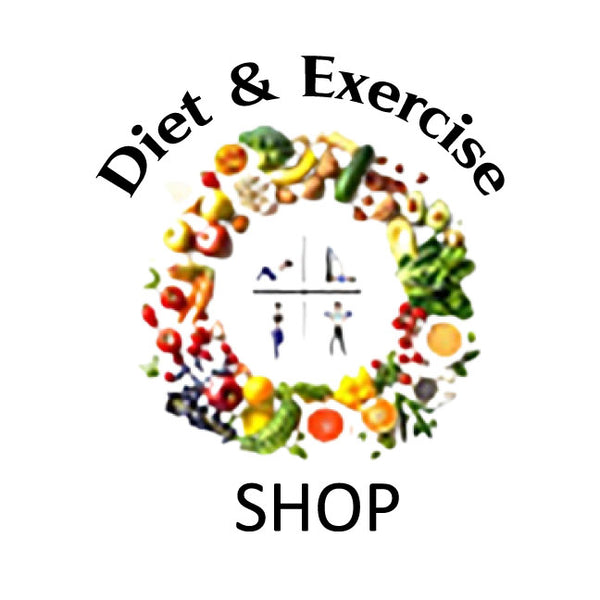
Master Keto Diet Meal Prep for Beginners
Keto meal prep is the practice of preparing your keto-friendly meals and ingredients for the week ahead. It's a game-changer for staying in ketosis.
When you have delicious low-carb, high-fat options waiting for you, you're far less likely to grab something carb-heavy. This is the best way to stay consistent and hit your health goals.
Why Keto Meal Prep Is Your Secret Weapon
Starting the ketogenic diet can feel overwhelming. The strict focus on macros—high fat, moderate protein, and very few carbs—demands attention.
Without a plan, it's easy to slip back into old habits, especially on a busy weeknight. This is where a good meal prep routine becomes your most powerful tool for success.
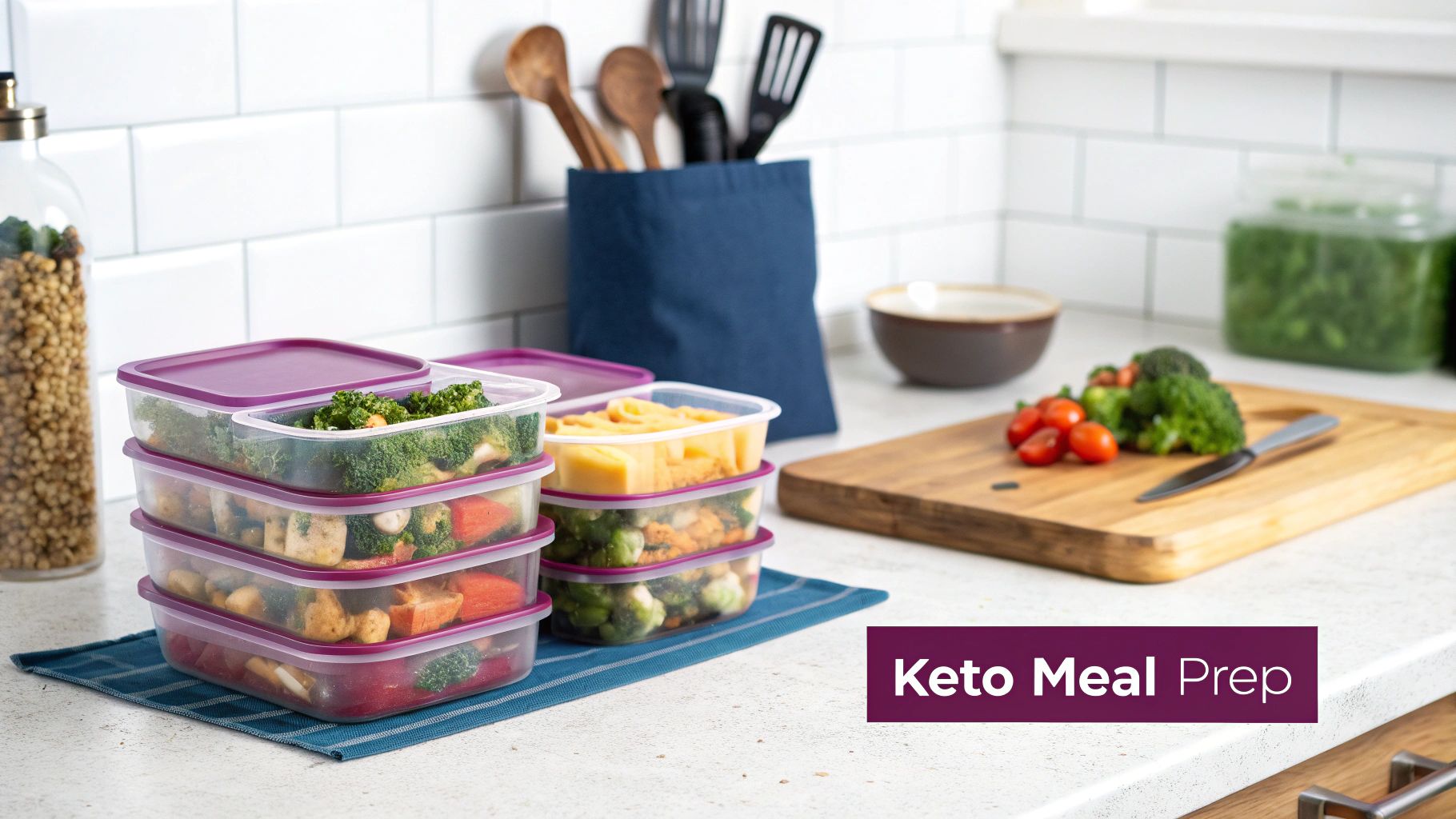
This is about more than just cooking ahead. It's about building a system that protects you from temptation and decision fatigue.
When your fridge is stocked with pre-portioned keto meals, the daily "what's for dinner?" stress vanishes. You get your evenings back and avoid unhealthy impulse buys.
Take Control of Your Macros and Goals
Staying in ketosis is all about tracking your macros accurately. When you meal prep, you gain complete control over every ingredient and portion size.
By weighing and dividing your food beforehand, you can be confident that every meal fits your specific targets. This consistency tells your body to start using fat for fuel—the entire point of the keto diet.
This approach is also fantastic for fitness goals like weight loss because it makes maintaining a caloric deficit simpler. You avoid hidden carbs and calories from takeout or restaurant meals.
A fridge full of prepped keto meals is your best defense against cravings and carb-loaded temptations. It turns a daily struggle into a sustainable lifestyle.
The Growing Trend of Smart Eating
People are looking for convenient, healthy ways to eat. The meal prep market was valued at USD 5.68 billion recently and is projected to hit USD 12.89 billion by 2033.
This growth shows a cultural shift towards being more health-conscious. It's driven by busy professionals and fitness enthusiasts who need nutritious, portion-controlled meals for their demanding schedules.
Stocking Your Keto Kitchen for Success
A great week of keto eating starts with a smart trip to the grocery store. When your kitchen is filled with the right foods, making healthy choices becomes easy.
Think of it as setting the stage for success. If you have delicious, keto-friendly ingredients ready to go, you're already most of the way there.
Your mission is to build a shopping list focused on high-quality fats, clean proteins, and low-carb vegetables. A good tip is to shop the perimeter of the grocery store where fresh, whole foods are located. The middle aisles are often filled with processed items with hidden sugars.
Mastering the Keto Shopping List
Your shopping list should reflect the keto macro ratio: lots of healthy fats, a moderate amount of protein, and very few carbs.
Prioritize healthy fats first, as they will be your main fuel source. Then, pick versatile proteins for different meals. Finally, load your cart with vibrant, non-starchy veggies for fiber and micronutrients.
Here's a list of keto essentials:
- Healthy Fats: Avocado oil, extra virgin olive oil, and coconut oil are great for cooking. Also stock up on avocados, almonds, macadamia nuts, and seeds like chia and flax.
- Powerhouse Proteins: You can't go wrong with eggs, chicken thighs, ground beef, fatty fish like salmon, and bacon.
- Low-Carb Vegetables: Load up on leafy greens like spinach and kale, plus broccoli, cauliflower, bell peppers, and zucchini. They're versatile and packed with nutrients.
- Pantry Staples: It's a good idea to have almond flour, coconut flour, a keto-friendly sweetener like erythritol, heavy cream, and full-fat cheeses on hand.
My Two Cents: Get in the habit of reading nutrition labels on everything. Calculate net carbs by subtracting Dietary Fiber from Total Carbohydrates. Sugar can be found in unexpected places.
To make things even easier, here is a simple checklist you can take with you to the store.
Your Essential Keto Shopping Checklist
| Category | Top Choices | Shopping Tips |
|---|---|---|
| Healthy Fats | Avocado Oil, Olive Oil, Coconut Oil, Ghee, Avocados, Macadamia Nuts, Almonds | Look for "cold-pressed" and "extra virgin" for oils. Buy nuts raw and unsalted to control sodium and avoid unwanted additives. |
| Proteins | Grass-fed Beef, Chicken Thighs, Salmon, Shrimp, Eggs, Bacon | Opt for fattier cuts of meat. For fish, wild-caught is usually a better choice than farmed. Always check bacon for added sugars. |
| Vegetables | Spinach, Kale, Broccoli, Cauliflower, Zucchini, Bell Peppers, Asparagus | Stick to non-starchy, above-ground vegetables. Buying frozen can be a budget-friendly way to stock up on staples like cauliflower and spinach. |
| Dairy | Heavy Cream, Butter, Full-Fat Cheeses (Cheddar, Mozzarella), Cream Cheese | Always choose full-fat versions to boost your fat intake and avoid the fillers and sugars often found in low-fat products. |
| Pantry & Spices | Almond Flour, Coconut Flour, Erythritol, Chia Seeds, Flax Seeds, Spices | These are the building blocks for keto baking and thickening sauces. A well-stocked spice rack is key to keeping meals interesting! |
This list provides a solid foundation for countless delicious keto meals. Keep it on your phone or print it out for your next shopping trip.
Essential Tools for Effortless Prep
You don't need a professional kitchen, but a few key tools will make meal prep much smoother.
A reliable food scale is a must-have. Eyeballing portions is a quick way to stall your progress. A scale removes the guesswork from tracking macros.
For storage, a good set of airtight glass containers is a game-changer. Unlike plastic, they won't stain or hold odors, and you can put them right in the microwave. These Mixing Bowls with Airtight Lids are fantastic for marinating, mixing, and storing.
Finally, a versatile appliance like an air fryer or slow cooker can be your best friend. An air fryer is great for crispy chicken or roasted vegetables, while a slow cooker turns tougher cuts of meat into tender masterpieces with minimal effort.
With a stocked kitchen, you're ready to cook. A smart keto meal prep session is about creating a smooth, strategic workflow that saves time and reduces stress.
The trick is to multitask effectively. Think of it like an assembly line. While chicken bakes in the oven, you can simmer a sauce on the stovetop or chop fresh greens for salads. This layered approach keeps you productive.
For a great visual on how this all comes together, the dietexercise channel has a solid walkthrough: Watch the Keto Meal Prep Workflow in Action.
Build Your Meals Around Core Proteins
A simple and powerful strategy is to cook one or two main proteins in bulk. Think shredded chicken, seasoned ground beef, or boiled eggs. These become the foundation for many different meals throughout the week.
This saves you from cooking from scratch daily and makes prep time efficient. For instance, a big batch of shredded chicken can be used in several different meals, giving you variety without starting over each night.
This infographic breaks down the foundational steps of any successful keto meal prep session.
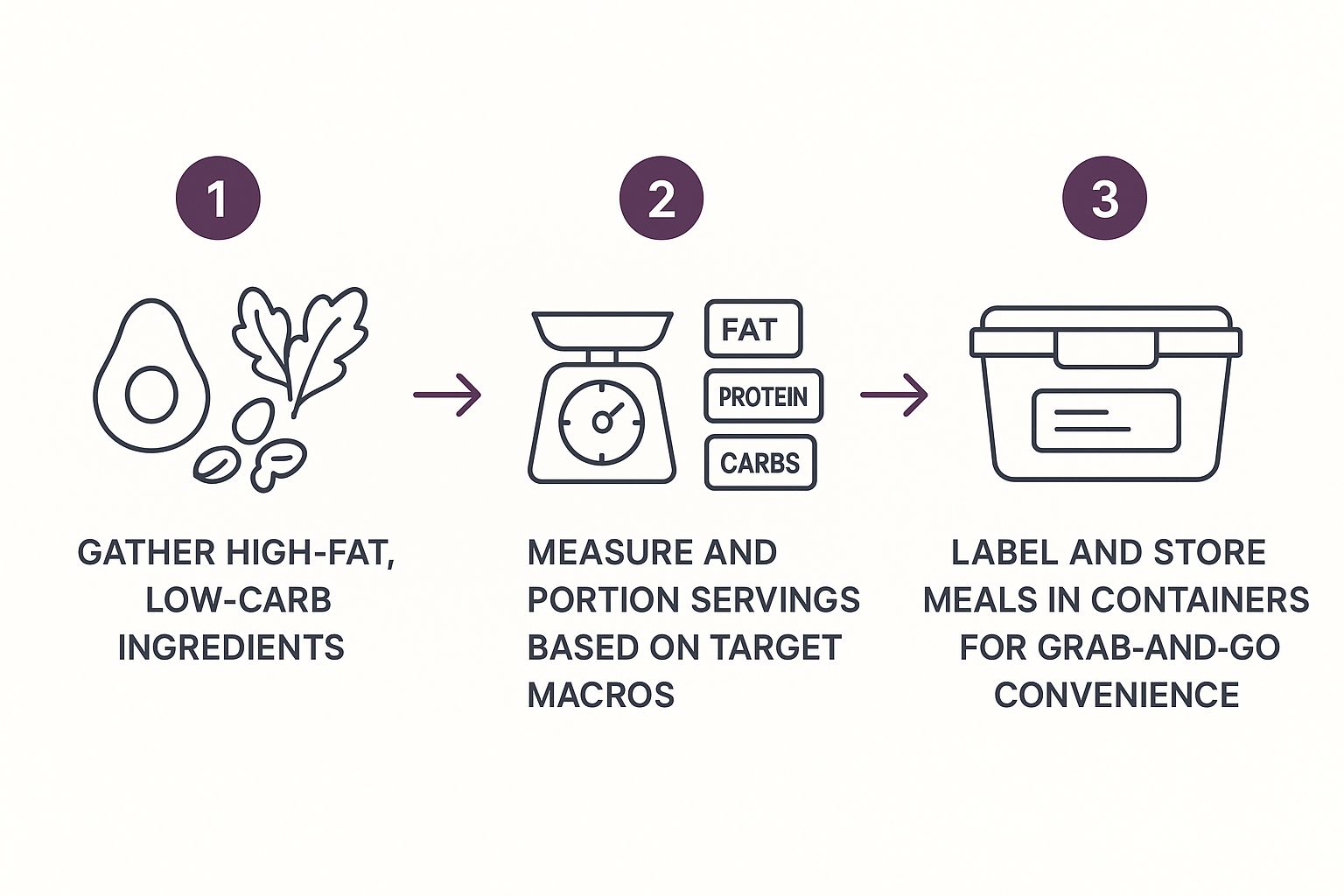
As you can see, the process flows logically: get keto-approved foods, portion them for your goals, and store them so they're ready to eat.
A Sample 3-Day Plan You Can Double
Here’s a simple 3-day meal plan to show you what this looks like. Just double the recipes, and you’re covered for six days. The star is that batch of shredded chicken we just talked about.
Day 1
- Breakfast: Keto Egg Muffins with spinach and feta.
- Lunch: Zesty Chicken Salad using pre-cooked shredded chicken, celery, and avocado mayo. Serve in lettuce cups.
- Dinner: Creamy Chicken and Broccoli Casserole, using that versatile shredded chicken.
Day 2
- Breakfast: Leftover Egg Muffins. Easy.
- Lunch: Leftover Chicken and Broccoli Casserole.
- Dinner: Taco Salad with seasoned ground beef, shredded lettuce, cheese, sour cream, and avocado.
Day 3
- Breakfast: A classic—scrambled eggs with a side of bacon.
- Lunch: Leftover Taco Salad.
- Dinner: Quick Chicken Lettuce Wraps with shredded chicken and a keto-friendly sauce.
By prepping just a few core components—shredded chicken, ground beef, and egg muffins—you’ve created nine different meals. This is the essence of efficient keto diet meal prep.
Tying Your Diet to Your Fitness Routine
Pairing a structured meal plan with your exercise routine is where you'll see the biggest changes.
If your goal is building lean muscle, eat your protein-rich meals (like the chicken casserole or taco salad) within an hour or two after a strength training session. This helps your muscles repair and rebuild.
For fat loss, the consistency of meal prepping is your best friend. It helps you stay in a caloric deficit. A morning cardio session, like a brisk walk, followed by a pre-portioned breakfast of egg muffins can stabilize your energy levels and prevent cravings.
To make your prep even smoother, a good set of containers is a game-changer. These versatile and durable Glass Meal Prep Containers are perfect for portioning meals.
Storing and Reheating Meals Like a Pro
You've spent a couple of hours shopping and cooking. Now, let's make sure that effort pays off all week. The secret to successful keto meal prep isn't just the cooking—it's how you store and reheat everything.
Get this part right, and your Friday lunch will taste just as fresh as it did on Sunday. It’s all about preventing soggy veggies and keeping meat tender.
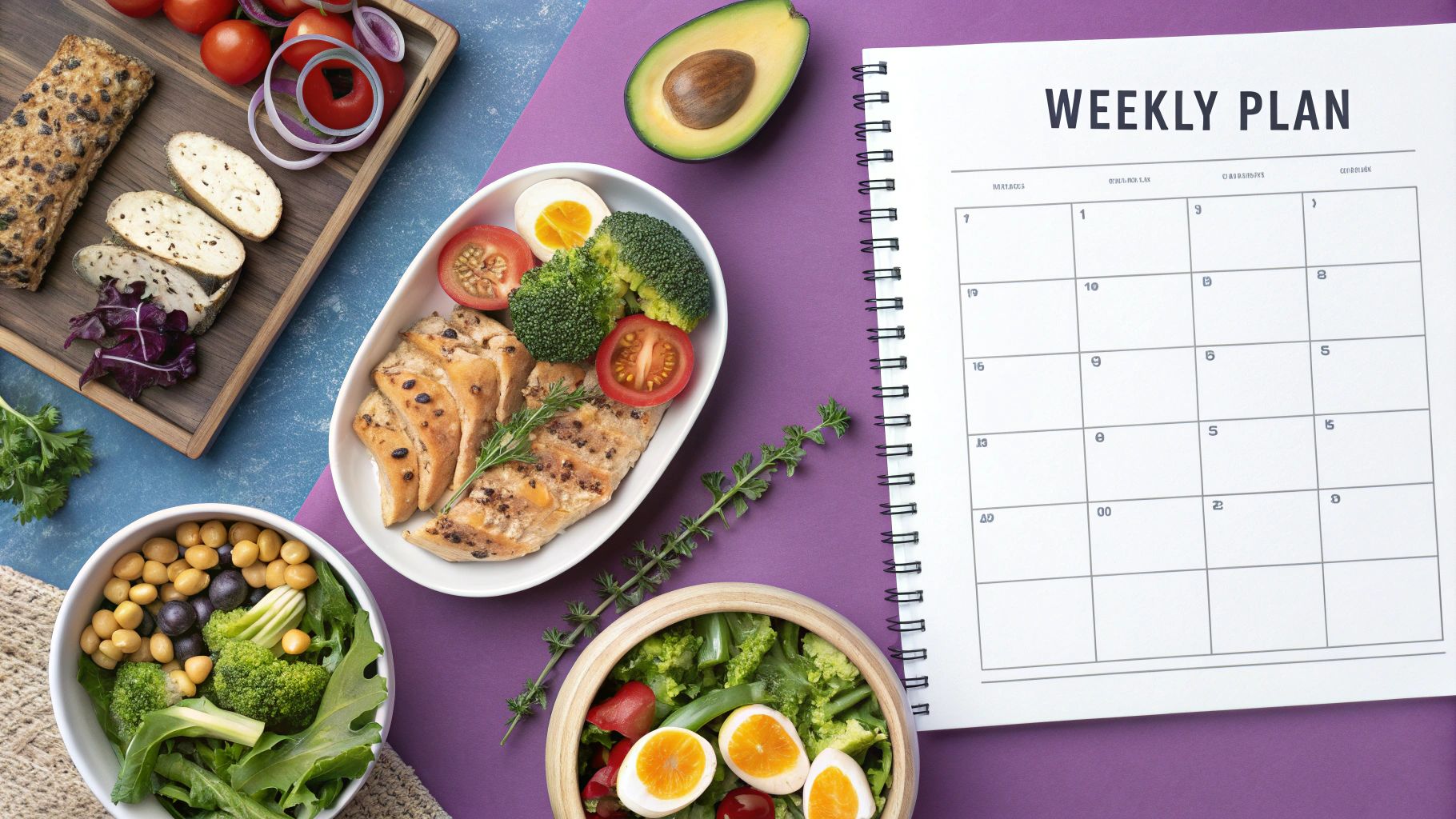
A few small adjustments in how you pack your food can make a world of difference.
First, Get the Right Gear
The containers you use have a massive impact on your food's quality. I almost always reach for glass containers.
Glass doesn't hold stains or smells, and it creates a better seal to keep food fresh. The biggest win for glass is its versatility. You can pop it straight from the fridge into the oven or microwave.
A quick pro-tip: Always match your container to how you plan on reheating. If the oven is your go-to, glass is your only safe bet.
Smart Tricks for Keeping Things Fresh
Once you have your containers, a few little habits can take your prep to the next level.
- Keep things separate. Store dressings, sauces, or any "wet" ingredient in its own container. Mix it in right before you eat to keep salads crisp.
- Use the paper towel trick. When you pack a salad or roasted veggies, stick a folded paper towel under the lid. It absorbs extra moisture and condensation.
- Cool everything down. Never put a lid on hot food. Let your meals cool completely first. This prevents steam from getting trapped inside, which is the number one cause of watery meals.
How to Reheat for the Best Taste and Texture
How you warm up your meal is just as important as how you store it. Step away from the microwave if you can; it can lead to rubbery chicken and limp broccoli.
For casseroles or baked chicken, the oven or a toaster oven is best. A moderate temperature brings them back to life without ruining the texture.
The air fryer is a real game-changer. It's brilliant for making crispy-skinned chicken thighs or roasted cauliflower taste like they were just cooked. It only takes a few minutes for a satisfying, perfectly textured meal.
Doing Keto Meal Prep on a Smart Budget
Committing to the keto lifestyle doesn't mean you have to commit to a huge grocery bill. With a few simple strategies, your weekly meal prep can be both delicious and affordable.
The trick is to focus on versatile, budget-friendly powerhouses instead of pricey ingredients.
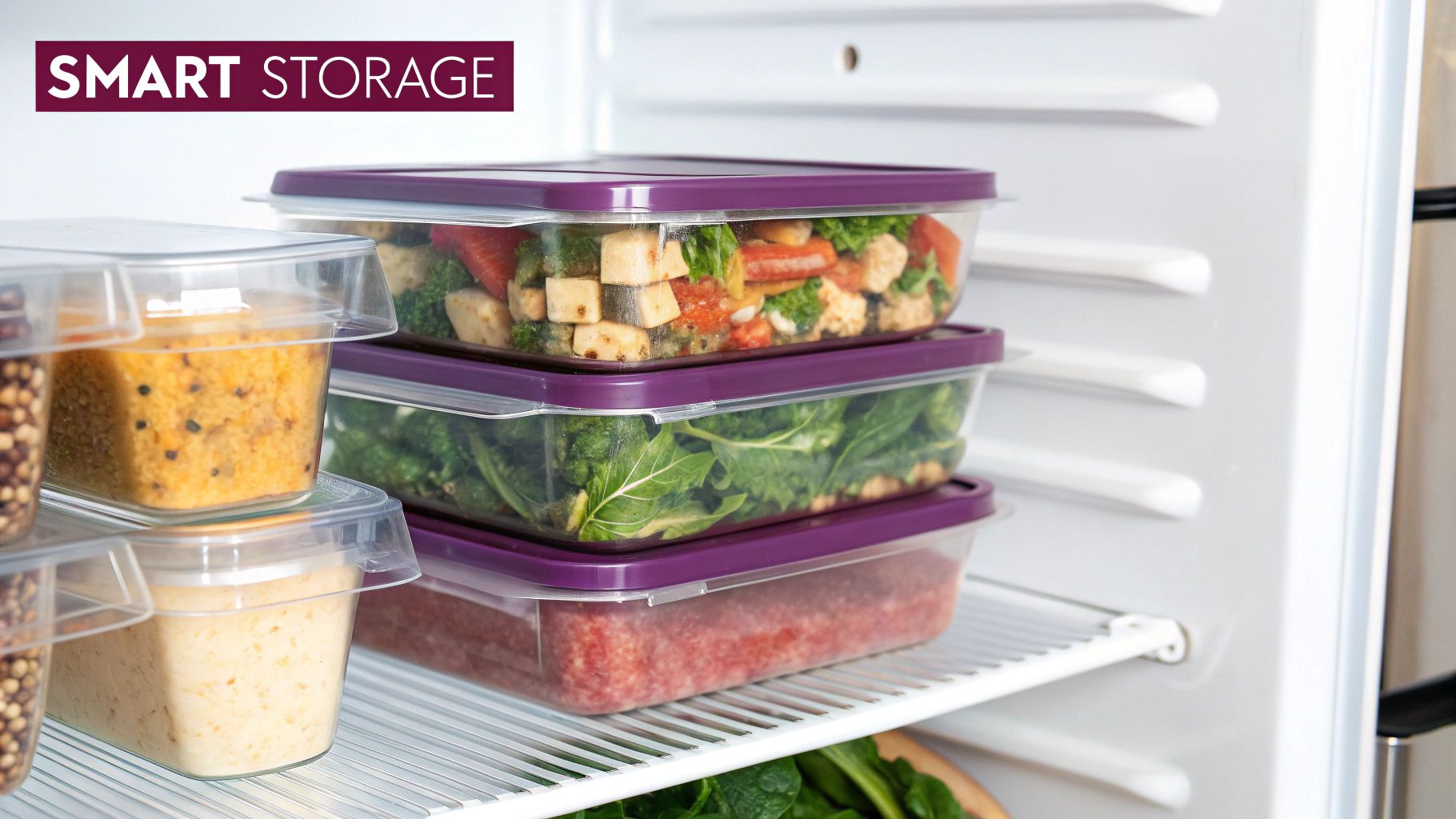
This approach is about building your menu around cost-effective staples like eggs, ground beef, and chicken thighs. These are packed with the protein and fat you need but are much kinder to your wallet than ribeye steak or fresh salmon.
Maximize Your Protein Budget
One of the best money-saving hacks is to embrace tougher, cheaper cuts of meat. A chuck roast or pork shoulder is perfect for batch-cooking in a slow cooker.
Simmer these cuts for hours, and they'll become incredibly tender and flavorful. You can shred them for tacos, salads, or casseroles for the entire week.
The financial side of keto often determines how long people stick with it. Grass-fed beef and wild-caught fish are great but can be expensive. The secret to budget keto is balancing quality with savvy shopping, using affordable items like eggs and frozen veggies.
Shop Smart and Reduce Waste
Getting strategic at the grocery store is a game-changer. Your mission is to get the most nutritional bang for your buck.
- Buy In-Season Veggies: Produce that’s in season is almost always cheaper and tastes better. Check local flyers for sales before planning your meals.
- Embrace the Freezer Aisle: Frozen vegetables like broccoli, cauliflower, and spinach are just as nutritious as fresh, last longer, and are often cheaper.
- Don’t Waste Scraps: Save onion ends, carrot peels, and chicken bones. Simmer them in water to create a flavorful, nutrient-rich bone broth for free.
Where to Save and Where to Splurge: I save money on produce by buying frozen or in-season options. I'd rather spend a little extra on high-quality cooking fats like avocado or extra-virgin olive oil, as they are the foundation of a healthy keto diet.
This thrifty mindset is a lifesaver for work lunches. When you have simple, inexpensive meals prepped, you avoid costly takeout. For inspiration, check out our guide on healthy lunch ideas for work that you can adapt for keto.
Common Keto Meal Prep Questions Answered
Jumping into keto meal prep is exciting but often comes with questions. Getting solid answers is the best way to build confidence and make this new habit stick.
The biggest concern is usually about food safety and freshness. You want your delicious meals to last through the week.
How Long Are Prepped Keto Meals Good For?
Generally, most cooked keto meals will last in an airtight container in the fridge for three to five days.
My rule is to eat anything with fish or seafood within three days. Heartier dishes like keto chili or chicken casserole can easily last the full five days.
A pro tip: always let your food cool down completely before you put the lid on. Trapped steam creates condensation, which leads to soggy meals. This simple step keeps food tasting fresh.
Can I Prep Without Cooking Full Meals?
Yes, absolutely! This is called "component prep" and is perfect if you get tired of eating the same thing every day. Instead of making identical meals, you prepare individual ingredients to mix and match.
A typical component prep session might look like this:
- Roasting a big tray of low-carb veggies like broccoli, bell peppers, and zucchini.
- Cooking a few pounds of protein, like grilled chicken breasts and browned ground beef.
- Washing and chopping all your salad greens for the week.
- Whipping up a big jar of keto-friendly vinaigrette for salads or marinades.
This way, you can throw together a fresh-tasting meal in just a few minutes each day, saving time without the monotony.
What Are the Biggest Keto Meal Prep Mistakes?
The single biggest mistake I see is a lack of variety. Eating the same meal every day is the quickest path to burnout and temptation. Prep at least two different options for lunches and dinners.
Another common pitfall is eyeballing portions. This can throw your macros off and stall progress. A simple food scale takes the guesswork out of portioning.
Finally, don't forget the fat! It's easy to focus on protein and skimp on healthy fats. Add avocado, a drizzle of olive oil, or a handful of nuts to your meals. This is crucial for staying in ketosis and feeling full. For more tips, the @DietExercise YouTube channel has great content, like this one about using the keto diet to lose weight.
At Diet and Exercise, we know that having the right tools makes all the difference. From workout gear to the kitchen essentials that make meal prep a breeze, we're here to support your journey to a healthier lifestyle. Check out our full collection at https://dietexerciseshop.com.
